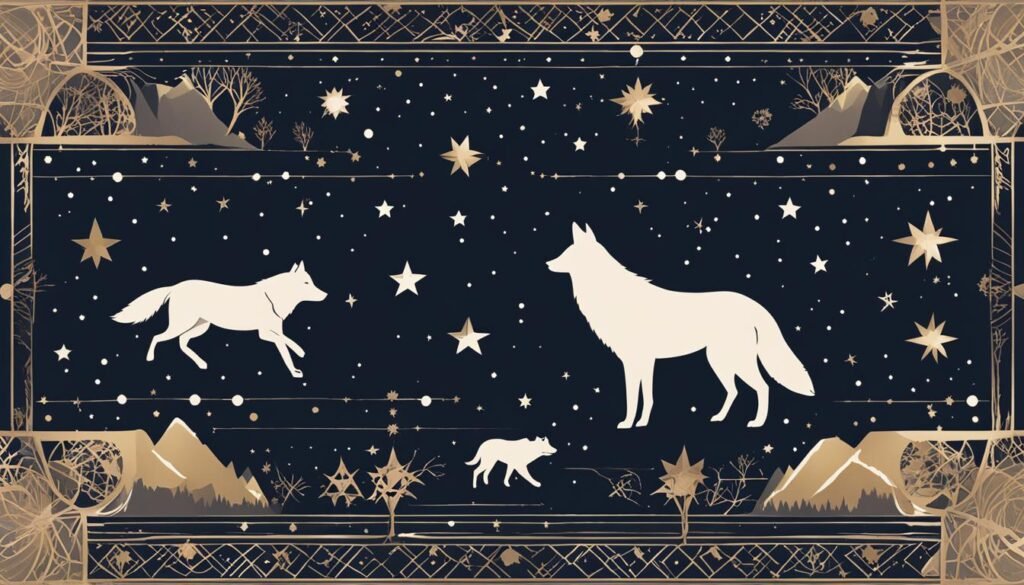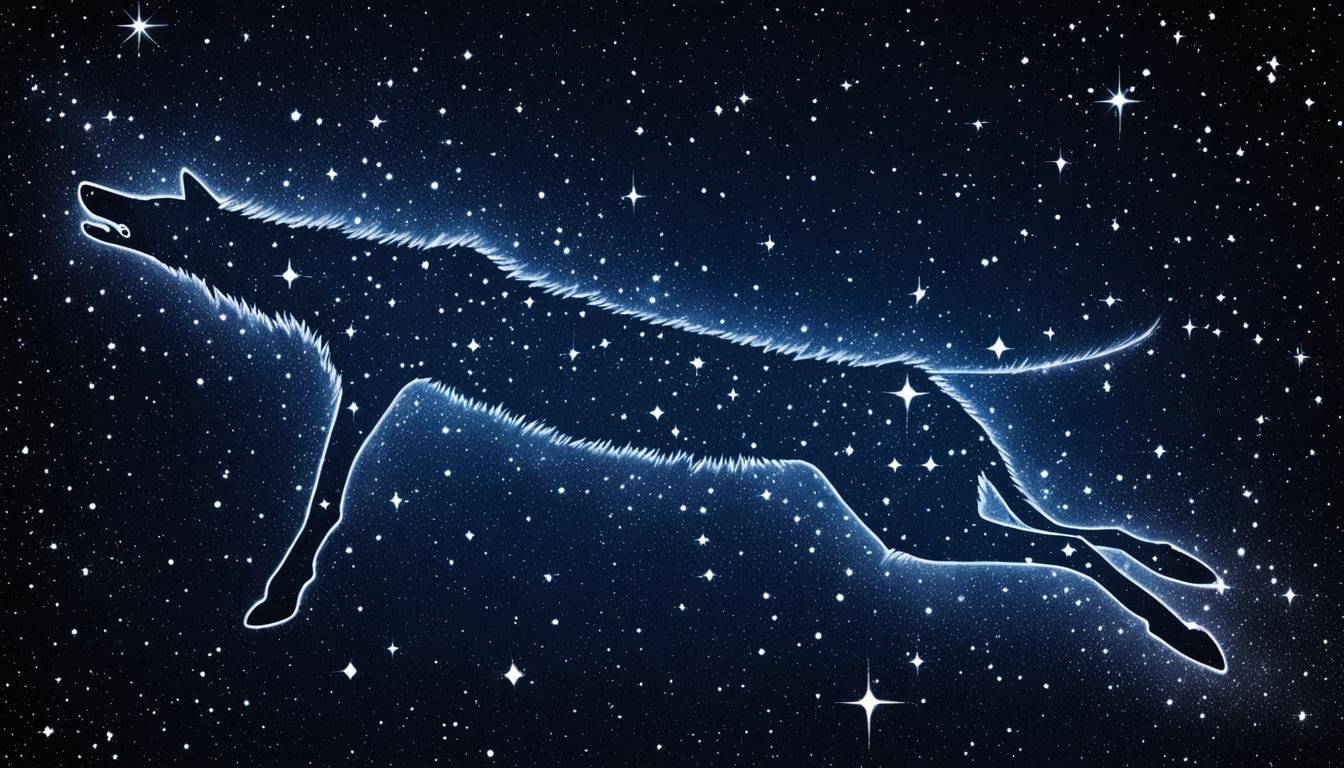| Genitive | |
| Abbreviation | |
| Pronunciation | |
| Main Stars | |
| Brightest Star | |
| Right Ascension | |
| Declination | |
| Sq. Deg. Area | |
| Crosses Meridian | |
| Visible Lat. Range |
As you turn your eyes to the Lupus night sky, a sense of wonder may wash over you as you gaze upon the constellation Lupus. This celestial tapestry has enthralled astronomers and constellation chasers alike. Nestled in the Southern Hemisphere, the Lupus Star Constellation spans an impressive 334 square degrees, offering a spectacle that humbly reminds us of the grandeur of the universe. Identified in the sky’s third quadrant, the stars that make up this constellation are visible from latitudes +35° to -90°, offering a broad swath of the globe a view of its brilliance.
With history dating back to the 2nd century when Ptolemy first cataloged it, the constellations hold no myths of its own but certainly contributes to the lore of the skies. The International Astronomical Union (IAU) solidified its legacy in 1922 with the abbreviation ‘Lup’, cementing its place among the cosmos. Its brightest star, Men (Alpha Lupi), shines at an apparent magnitude of 2.30, standing proudly as a beta Cephei variable. The Lupus stars are also hosts to deep sky delights like the remnants of supernova SN 1006 and the enchanting globular clusters NGC 5824 and NGC 5986.
Through the lens of your telescope or with the naked eye, the Lupus Star Constellation becomes a gateway to an ancient story. Its astronomical significance continues to expand as we discover planets orbiting its stars, making it a constant source of fascination and discovery in the vast Lupus night sky.
Key Takeaways
- Lupus Constellation is a southern celestial marvel occupying 334 square degrees in the sky.
- Visible to observers between latitudes +35° and -90°, it’s a highlight for stargazers worldwide.
- Ptolemy’s early documentation conveys the constellation’s historical astronomic importance.
- Lupus is marked by noteworthy stars including Men, notable for its brightness and variability.
- Despite its lack of mythological connections, Lupus’s deep sky objects like SN 1006 add to its intrigue.
- The discovery of planets within the Lupus constellation underscores its scientific significance.
- For aficionados of the heavens, Constellation Lupus remains an endlessly captivating subject.
An Overview of the Constellation Lupus
Embarking on a celestial journey, your gaze may eventually lock onto the Lupus Celestial Body, a constellation that boasts a rich history and is steeped in astronomical significance. Tucked away in the southern hemisphere’s star-studded tapestry, Lupus is not merely a collection of stars; it represents centuries of human observation and storytelling reflected in the night sky.
Pinning Down Lupus in the Night Sky
When you search for Lupus, you’re looking for a constellation that is a mosaic of the cosmos itself. With a Lupus Constellation Map in hand, it becomes apparent that to spot this celestial wonder, you would aim for the coordinates 15h 18m 00s right ascension, and −45° 00′ in declination. Perfect for those situated in the southern hemisphere, Lupus reveals itself as an enduring figure in the vast expanse above.
The Hercules Family of Constellations
The story of Lupus is intertwined with its larger family, the Hercules family of constellations. As a member of this prominent group, it keeps cosmic company with famed constellations such as Centaurus, Scorpius, and Libra. Lupus, once thought to be part of Centaurus, has evolved in both name and stature, now standing firmly on its own as a unique piece of the celestial puzzle. The myths and stories surrounding Lupus trace back to several cultures, displaying how human fascination with the Constellation Lupus Facts, interpreted in various ways from the Greeks to the Romans, has contributed significantly to shaping its identity.
In understanding the grandeur of Lupus, you appreciate not only a dazzling array of stars but also a symbol of humanity’s timeless tendency to find meaning amidst the vastness of the universe.
Unraveling the Mystery of Constellation Lupus
Delving into the rich tapestry of Lupus Mythology, you’ll find a narrative woven by various ancient civilizations, each rendering the Lupus Constellation through a lens of awe and reverence. The Greeks immortalized Lupus as a representation of a wild animal, a testament to the constellation’s raw power and untamed spirit in the night sky. Contrasting this, the Babylonians envisioned a majestic hybrid creature named UR.IDIM, bridging the gap between the realms of man and myth, lion and human, bearing testimony to the grandeur and mystery embed within the stars.

The narrative threads across cultures do not end there, for in Arab folk astronomy, the constellation Lupus took the shape of date palm branches, echoing the importance of this tree in sustaining life and symbolizing prosperity. This constellation’s historical significance extends beyond a single form, encapsulating a variety of shapes and interpretations, culminating in a collective imagery shared with the constellation Centaurus, signifying the timelessness and interconnectedness of celestial myths.
Uncovering the layers of Lupus Constellation History, we observe a commonality in how ancient observers of the cosmos attributed the majestic and the ferocious within nature to the patterns they discerned in the stars. This section intends to spotlight the profound relationship between humanity’s penchant for myth-making and their interpretations of the starlit canvases above. Journey with us as we explore the imposing visual legacy of Lupus, a constellation that has stood as a sentinel in the history of astronomical observation and cultural symbolism.
The Brightest Stars of Lupus Celestial Body
As you explore the night sky, the Lupus Stars capture the imagination with their celestial glow. The constellation of Lupus presents a theatre of the cosmos, with its array of brilliant luminaries and intriguing multiple star systems. One prominent figure in this constellation is Alpha Lupi, known as the beacon of Lupus for its remarkable brightness and variation.
Alpha Lupi – The Luminary of the Wolf
Alpha Lupi, sitting approximately 460 light-years away from Earth, is not just any star—it is a blue-white giant renowned for its Beta Cephei variable characteristics. With an apparent magnitude of 2.30, this standout star in the Lupus constellation makes a profound impact on the night canvas. But it adds to its allure with rapid brightness fluctuations over a period of a little more than 7 hours.
Not Just a Single Star – Exploring the Multiple Star Systems
Diving deeper into the wonders of Lupus, multiple star systems like Epsilon Lupi present an exquisite display of cosmic interplay. Considered a spectroscopic binary, this system comprises two stars locked in a gravitational ballet, circuiting one another every 4.55 days—offering a dynamic spectacle for stargazers.
Luminosity Variations: The Beta Cephei Variables in Lupus
The constellation’s complexity is further enhanced by other Beta Cephei Variables, such as Beta and Delta Lupi. These stars contribute to the variable nature of Lupus with their luminosity changes, making it a constellation full of surprises and celestial phenomena that await discovery.
| Lupus Star | Star Type | Apparent Magnitude | Variable Type | Observation Period |
|---|---|---|---|---|
| Alpha Lupi | Blue-White Giant | 2.30 | Beta Cephei | 7+ hours |
| Epsilon Lupi (A & B) | Spectroscopic Binary | 3.37 | Stable | 4.55 days |
| Beta Lupi | Giant | 2.68 | Beta Cephei | Variable |
| Delta Lupi | Blue Giant | 3.22 | Beta Cephei | Variable |
Whether you’re an amateur astronomer or a seasoned cosmic observer, the stars of Lupus, such as Alpha Lupi, and its multiple star systems, including intriguing Beta Cephei variables, provide a window into the dynamic and endlessly fascinating universe.
Historical Significance and Mythology of Lupus Star Constellation
Immersing yourself in the history of the Lupus Star Constellation is like undertaking a journey through various civilizations and eras that have contributed to its storied past. For ancient Egyptian and Babylonian societies, the demarcation of this constellation played a role both astronomically and mythologically, tied deeply to their cultural narratives and deities.
From an Egyptian Mad Dog to a Greek Wild Animal
The intricate tapestry woven by the imagery of the Lupus constellation reveals a compelling transformation over time. In its earliest depictions, Egyptian and Babylonian mythologies depicted Lupus as a powerful celestial entity, the “Mad Dog,” an emblem of the fierce and the divine. The stars that comprise the modern constellation were perceived to reflect the essence of powerful beings from their pantheons, representing a symbiosis between the celestial and the terrestrial realms. As the torch of civilization was passed, the Greeks reimagined this celestial figure as Therium, still fierce but with a form closer to that of the wild animals familiar to their world.
The Renaissance’s Lupine Association
It was not until the dawning of the Renaissance that Lupus found its place in Western tradition as the iconic wolf, an image that aligns well with contemporary representation. This pivotal period in human history, rich in art and philosophy, led to the rebranding of many constellations, including Lupus, which was previously seen through the lenses of various cultures as different beasts. These shifts reveal an ever-evolving narrative assigned to the stars, highlighting Lupus Mythology as a dynamic character in the celestial saga.

Today, while Lupus Zodiac Sign is not formally recognized within the traditional 12 Zodiac signs, the mystique of Lupus continues to enchant. Whether you’re scouring historical texts or gazing up at the night sky, the Lupus Constellation Myths serve as a testament to humanity’s quest to make sense of the stars, offering endless inspiration to both the scholarly and the star-struck observer.
Constellation Lupus and Its Deep Sky Marvels
As you gaze upon the southern skies, you’ll discover that the Constellation Lupus is more than just a collection of stars. It’s a treasure trove of Lupus Deep Sky Objects beckoning to be explored. Among these cosmic wonders, you’ll find remnants of celestial history and windows into the universe’s past.
Globular Clusters Hidden Within Lupus
Delve deeper into the heart of Lupus, and you will encounter astounding globular clusters. These spherical collections of stars are densely packed and hold stories as old as time itself. Let’s take a closer look at a couple of the most prominent clusters residing within the bounds of this constellation.
| Cluster Name | NGC Number | Characteristics |
|---|---|---|
| NGC 5824 | 5824 | An ancient and densely populated sphere of stars observable with a telescope |
| NGC 5986 | 5986 | A globular cluster rich in history and visible under dark sky conditions |
Planetary Nebulas and Supernova Remnants
While exploring Lupus, you’ll be enthralled by the cosmic spectacle of planetary nebulas – the remnants of stars like our own Sun that have shed their outer layers. The Lupus Constellation Planetary Nebula whispers the tales of stellar evolution. Notably, IC 4406, reveals intricate patterns and dust lanes, offering a glimpse into the life cycle of stars.
And let’s not forget the supernovae remnants that paint a picture of violent stellar deaths which once outshone entire galaxies. SN 1006 stands as a testament to these monumental explosions. Witnessing these Lupus Deep Sky Objects provides not only aesthetic wonder but also invaluable insight into cosmic phenomena.
- IC 4406 – Known as the Retina Nebula, admired for its rectilinear dust lanes
- SN 1006 – A supernova remnant that remains one of the brightest in recorded history
Lupus is a constellation that’s rich in celestial wonders, inviting you to discover its deep sky objects and planetary nebulas, each offering a unique narrative of the universe’s grandeur and complexity.
Lupus Constellation’s Place in Astrology
Despite Lupus not being one of the traditional zodiac constellations that form the celebrated astrological calendar, this southern arrangement of stars intricately weaves its own narrative into the broader context of Lupus Astrology. For those of you who delve into the cosmic symbols, it’s worth noting that constellations like Lupus, which lay outside the celestial path of the Zodiac, bring their own distinct flavors to the astrological dialogue. The absence of Lupus in common horoscopes doesn’t detract from its astrological relevance—it instead offers a metaphor of instinct, intelligence, and survival mirrored by its wolf emblem.
As you explore the subject of Lupus Zodiac Sign, its position in the firmament may not dictate your fortune or personality traits as the mainstay solar zodiac signs do, but it imparts an ancestral whisper from the cosmos. Occupying its place beneath the ecliptic, Lupus is like a celestial undercurrent subtly influencing the astrological world with its presence. Its symbolic connection to the wolf adds a layer of primal essence, suggesting that the wisdom of Lupus is one of untamed natural force and keen perception, characteristics esteemed within the astrological community.
For your astrological considerations, remember that the stars and constellations extend their significance beyond the traditional horoscope. Lupus, although less prominently featured in modern astrology, enriches your understanding of the astral plane with every rising and setting. Its cosmic profile recapitulates the wildness of the universe—a theme that has perennially captivated humanity’s quest for meaning in the night sky.
FAQ
Where is the Constellation Lupus located in the night sky?
Constellation Lupus is situated in the Southern Sky between latitudes +35° and -90°. It is found in the third quadrant (SQ3) of the southern hemisphere and can be identified using coordinates 15h 18m 00s right ascension and -45° 00′ declination.
What are the main stars and objects of interest in Lupus?
The main stars in Lupus include Alpha Lupi (Men), the brightest star, and multiple systems like Epsilon Lupi. Interesting deep sky objects within Lupus are the globular clusters NGC 5824 and NGC 5986, and the supernova remnant SN 1006, one of the brightest supernovae in recorded history.
Is the Lupus constellation associated with any myths?
While the Lupus constellation is not tied to any specific myths in Greek or Roman traditions, various ancient cultures like the Babylonians and Egyptians referenced the stars within Lupus to represent a creature known as UR.IDIM or the Mad Dog, often connected to divine entities. Lupus has been portrayed throughout history as an imposing creature, with its symbolic meaning evolving over time.
What is the significance of Alpha Lupi?
Alpha Lupi, also known as Men, is the brightest star in the Lupus constellation, with an apparent magnitude of 2.30. It is approximately 460 light-years away from Earth and is a blue-white giant star. As a Beta Cephei variable, its brightness fluctuates with a period of just over 7 hours, making it a significant point of interest for astronomers.
Can Lupus be seen from the Northern Hemisphere?
Lupus is primarily visible from the Southern Hemisphere and cannot usually be seen from most locations in the Northern Hemisphere. For observers located at southern latitudes, it is more easily observable in the night sky.
What kind of celestial events can be seen in Lupus?
Within the constellation of Lupus, observers can view several celestial events, notably the supernova remnant SN 1006. Although there are no major meteor showers associated with Lupus, the stars within speak volumes, including the Beta Cephei variables, which exhibit luminosity variations.
Does Lupus have any relation to astrological signs?
No, Lupus is not one of the 12 traditional zodiac signs that lie along the ecliptic path. However, in astrology, the presence of celestial bodies outside the Zodiac still carries symbolic significance. In the case of Lupus, the wolf archetype represents instincts, intelligence, and appetites that enrich astrological interpretations.
What are the Beta Cephei Variables in Lupus?
Beta Cephei variables are a type of star that exhibits changes in brightness due to pulsations of their surface layers. In the constellation of Lupus, notable Beta Cephei variables such as Alpha Lupi, Beta, and Delta Lupi contribute to the celestial body’s unique traits and are a point of study for their stellar behavior.
How do the stories of Lupus vary across different cultures?
In ancient cultures, Lupus was depicted differently—Babylonians visualized it as a creature named UR.IDIM, Egyptians associated it with the sun god, and Greeks labeled it as Therium (wild animal). Each iteration of the Lupus constellation reflects the respective culture’s imagination and their connection with the natural and divine world.
Are there any notable clusters or nebulae in the Constellation Lupus?
Yes, Lupus is home to several notable clusters and nebulae, including globular clusters such as NGC 5824 and NGC 5986, teeming with ancient stars. It also contains the fascinating planetary nebula IC 4406, known as the Retina Nebula, which is distinguished by its dust lanes. These deep sky marvels make Lupus a constellation of considerable interest for deep sky observation.






